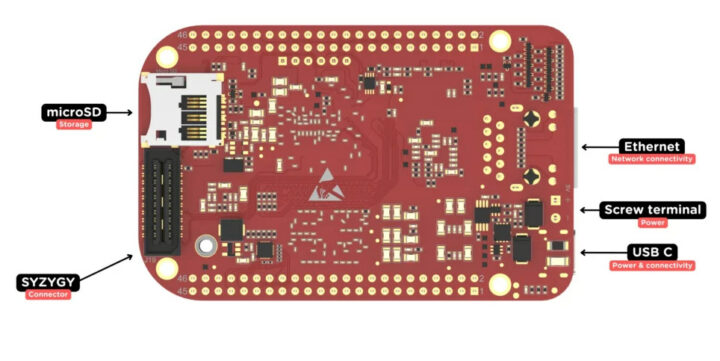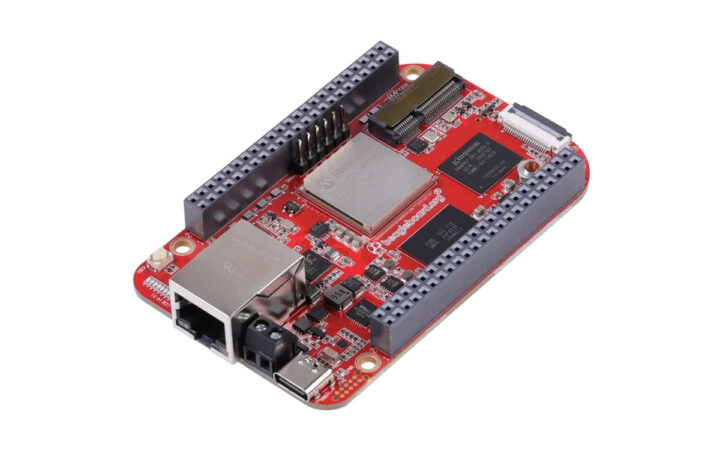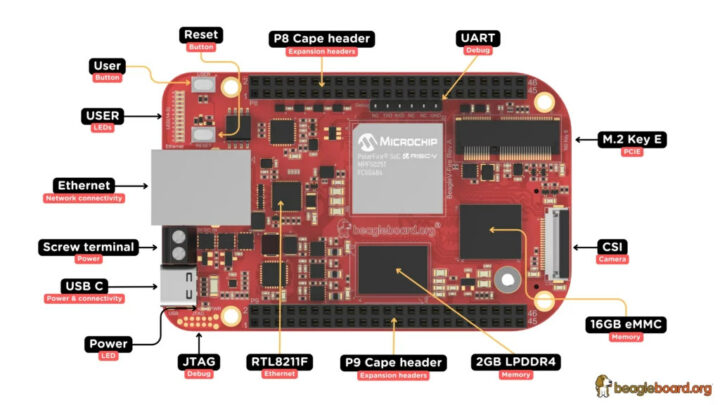BeagleV-Fire is a new single board computer powered by Microchip PolarFire MPFS025T penta-core RISC-V SoC FPGA that follows the BeagleBone Black form factor for compatibility with BeagleBone capes expansion boards.
Microchip PolarFire RISC-V SoC FPGA was one of the first Linux-compatible RISC-V SoCs and was found in pricey boards such as the Icicle and TySOM-M-MPFS250 development boards. I also got an Icicle board for review, and while getting started with the Yocto Linux BSP was OK, I really struggled with the FPGA part including just installing Libero SoC in Ubuntu and going through the license, and even I gave up trying to run a bitstream sample on the board due to a lack of time. The BeagleV-Fire makes it much cheaper to try out the PolarFire and hopefully makes it easier to get started with both Linux and the FPGA fabric through easier-to-understand documentation and code samples.
BeagleFire-V specifications:
- SoC – Microchip Polarfire MPFS250T FCVG484E SoC FPGA
- Penta-core RISC-V CPU
- Quad-core 64-bit RV64IMAFDC (RV64GC) application processor @ up to 667 MHz, 3.125 CoreMarks/MHz, 1.714 DMIPS/MHz
- 1x 64-bit RV64IMAC monitor core
- FPGA fabric
- 23K logic elements (4-input LUT + DFF)
- 68 Math blocks (18×18 MACC)
- 4 SerDes lanes of 12.7 Gbps
- Penta-core RISC-V CPU
- System Memory – 2GB LPDDR4
- Storage
- 16GB Kingston eMMC
- 128Mbit SPI flash
- MicroSD card socket
- Camera I/F – 22-pin MIPI CSI camera connector
- Networking
- Gigabit Ethernet RJ45 port via Realtek RTL8211F
- Optional WiFi via M.2 E-Key socket
- USB – 1x USB 2.0 Type-C port (480Mbps) with dual-role support and power input
- Expansion
- M.2 E-Key socket for WiFi and other PCIe/SDIO modules
- 2×46-pin BeagleBone Cape add-on headers with on-board ADC
- SYZYGY high-speed connector
- Debugging
- 6-pin 3.3V UART header
- JTAG TAG-CONNECT footprint
- Misc
- Reset and user buttons
- Power LED, multiple user LEDs
- Power Supply
- 5V via USB Type-C
- 5V via 2-pole screw terminal
- Dimensions – 86.4 x 53.4 mm (same dimensions as BeagleBone Black)
 BeagleV-Fire comes with Ubuntu preinstalled so it should be easier to get started out of the box than with a Yocto Linux image. Having said that flashing another Linux image is still a convoluted process as you need to connect a USB-to-UART debug board to access the serial console, switch the board to mass storage mode, and then flash the image (sdcard.img) using BalenaEtcher or other tools. FPGA programming is still done with the Libero SoC program and still requires the user to get a free Libero Silver license… The work-in-progress documentation has more details about the board and basic instructions to get started, but so far no demos although both a CSI camera capture demo and a cape compatibility layer demo are in the plan. You’ll also find the hardware design files, the RISC-V toolchain, the Ubuntu image build script, and other resources on BeagleBoard’s GitLab server.
BeagleV-Fire comes with Ubuntu preinstalled so it should be easier to get started out of the box than with a Yocto Linux image. Having said that flashing another Linux image is still a convoluted process as you need to connect a USB-to-UART debug board to access the serial console, switch the board to mass storage mode, and then flash the image (sdcard.img) using BalenaEtcher or other tools. FPGA programming is still done with the Libero SoC program and still requires the user to get a free Libero Silver license… The work-in-progress documentation has more details about the board and basic instructions to get started, but so far no demos although both a CSI camera capture demo and a cape compatibility layer demo are in the plan. You’ll also find the hardware design files, the RISC-V toolchain, the Ubuntu image build script, and other resources on BeagleBoard’s GitLab server.
That also means BeagleBoard.org now has two RISC-V boards namely the BeagleV-Ahead with Linux and AI capabilities and the BeagleV-Fire with Linux and FPGA fabric for even more flexibility. The new BeagleV-Fire is now available for $149 and up from various distributors such as Mouser, Digikey, and OKdo/RS Components among others. Further information may also be found on the product page.

Jean-Luc started CNX Software in 2010 as a part-time endeavor, before quitting his job as a software engineering manager, and starting to write daily news, and reviews full time later in 2011.
Support CNX Software! Donate via cryptocurrencies, become a Patron on Patreon, or purchase goods on Amazon or Aliexpress






